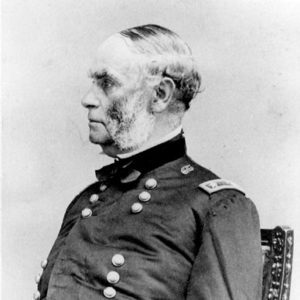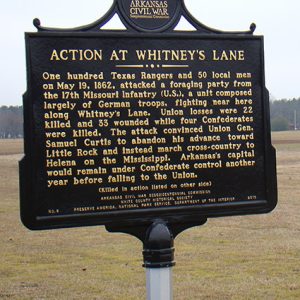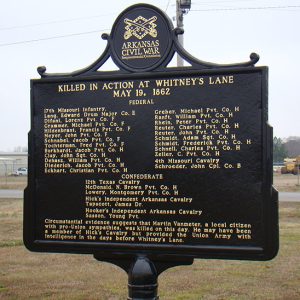calsfoundation@cals.org
Action at Whitney's Lane
aka: Skirmish at Searcy Landing
| Location: | White County |
| Campaign: | Pea Ridge Campaign |
| Dates: | May 19, 1862 |
| Principal Commanders: | Major General Samuel R. Curtis (US); Major General Earl Van Dorn (CS) |
| Forces Engaged: | Army of the Southwest (US); Army of the West (CS) |
| Estimated Casualties: | 55 (US); 4 (CS) |
| Result: | Confederate victory |
The Action at Whitney’s Lane was the first major contact between Federal and Confederate forces in Arkansas after the Battle of Pea Ridge on March 6–7, 1862. This action and subsequent events led the Union army to give up its objective to capture Little Rock (Pulaski County) in May 1862. Little Rock did not fall under Federal control until September 1863.
Union Major General Samuel R. Curtis’s defeat of the Confederate forces under Major General Earl Van Dorn at the Battle of Pea Ridge had not been altogether decisive, but he could claim victory. Consequently, Confederate command staff in the east conceded much of the western region of the Confederacy known as the Trans-Mississippi and ordered Van Dorn to take Arkansas troops to Mississippi to assist in the defense of Corinth. Curtis received orders on May 2, 1862, to “move as rapidly as possible, sending such portion of your cavalry and artillery as you deem necessary to occupy Little Rock and Jacksonport,” (the latter in Jackson County).
On May 3, 1862, Curtis arrived in Batesville (Independence County), perhaps as little as a three-day march from Little Rock. He set up headquarters and deployed his forces. The Third Division was given to Colonel Peter J. Osterhaus, who commanded a regiment of mostly German immigrant troops (the Seventeenth Missouri Infantry) from St. Louis, Missouri. His orders were to move with a reconnaissance force down to the Little Red River in White County.
It is difficult to know how many Confederate forces were in Little Rock, but few were there, most from the Twelfth Texas Cavalry. Colonel William H. Parsons had been leading the way across Arkansas for several Texas regiments that expected to be fighting across the Mississippi River. But four companies of the Twelfth, with more to arrive soon, were camped in Little Rock. Independent units roamed the state then, but nothing of any size. Yet home guards, independent companies, new volunteers, and the Texas units were converging. Curtis, who could have had Little Rock in early May with only its few defenders, faced an ever-growing and more determined enemy.
On May 19, 1862, Curtis broke camp, crossed the White River at Batesville, and began what he thought would be a short march to Little Rock. At the same time, elements of Osterhaus’s division crossed the Little Red River at Searcy (White County) to forage. Unknown to them, Major Emory Rogers of the Twelfth Texas Cavalry, with a detachment and two local companies, was watching their movements, guided by Captain Francis M. Chrisman, an independent Arkansas cavalry officer. The Federal foraging detachment was divided into three groups, one of which was posted at an intersection of Whitney’s Lane, a few miles east of Searcy on the West Point Road, which connected three farms. Rogers took 100 of his men and fifty locals, composed of Captain William T. Hicks’s and Captain Richard Hooker’s men, and bolted into action.
Arkansans and Texans rode down on the intersection, enveloping the posted guard. They pummeled the Federal troops, who tried to protect themselves behind a rail fence. One by one, the Union troops fell, and all of them became casualties. Union Sergeant Conrad Shaub of the Seventeenth Missouri Infantry testified at a hearing, “I must declare that warfare like the one my company experienced yesterday I believed belonged among the impossibilities among civilized nations.” An estimated twenty-two Federal troops died, and thirty-three were wounded. The Confederates captured a Union surgeon and four ambulance wagons. The Arkansans and Texans lost only four, and a few were wounded.
Curtis turned back at Caney Creek six miles south of Batesville, where he had received news of the Action at Whitney’s Lane, convincing him that a formidable Confederate force could be in his front and thus requiring him to reconsider his forward movement. Osterhaus stayed in the Searcy area, and skirmishing continued while Curtis evaluated his position. Guerrilla tactics and misinformation taxed the Federal troops. Front line Union troops began to hear, inaccurately, that as many as 20,000 Confederates were advancing. With renewed hope, Major General Thomas C. Hindman took over command in Arkansas. Thousands of Texans were pouring in. Arkansans began enlisting. Curtis’s generals advised him that his position was untenable and that a retrograde movement was necessary. Arkansans and Texans had managed to spread out sixty miles in front of the Army of the Southwest (US).
On June 25, 1862, Curtis finally gathered his forces and moved down the north and east sides of the White River towards Helena (Phillips County), abandoning his Little Rock objective. Not until September 1863 did Union Major General Frederick Steele, and not Curtis, occupy Arkansas’s capital. The action at Whitney’s Lane also revitalized Confederate Arkansas’s war effort, the people of Arkansas believing that the Federal troops were retreating. A Little Rock newspaper editor remarked, “We regard this as one of the most daring and brilliant feats of the war, and, if properly followed up… the result will be the expulsion of the Yankees from Arkansas soil,” and “Major Rogers deserves the thanks of the people of Arkansas for the check he gave the enemy.”
For additional information:
Akridge, Scott H., and Emmett Powers. A Severe and Bloody Fight: The Battle of Whitney’s Lane & Military Occupation of White County, Arkansas, May & June, 1862. Searcy, AR: White County Historical Museum, 1996.
Anderson, John Q., ed. Campaigning with Parsons’ Texas Cavalry Brigade, CSA: The War Journals and War Letters of the Orr Brothers, 12th Texas Cavalry Regiment. Hillsboro, TX: Hill Junior College Press, 1967.
Emmett E. Powers
Lonoke, Arkansas
 Civil War Timeline
Civil War Timeline Military
Military Samuel Curtis
Samuel Curtis  Earl Van Dorn
Earl Van Dorn  Whitney's Lane Marker
Whitney's Lane Marker  Whitney's Lane Marker
Whitney's Lane Marker 




Comments
No comments on this entry yet.